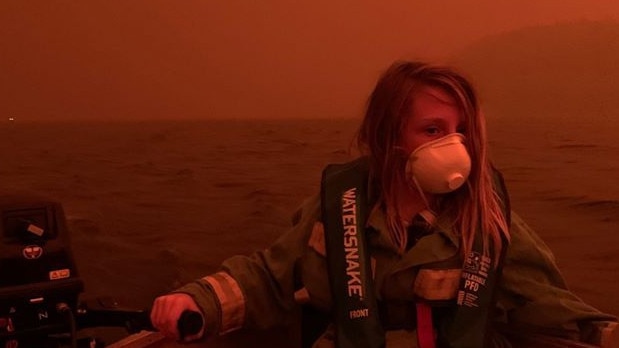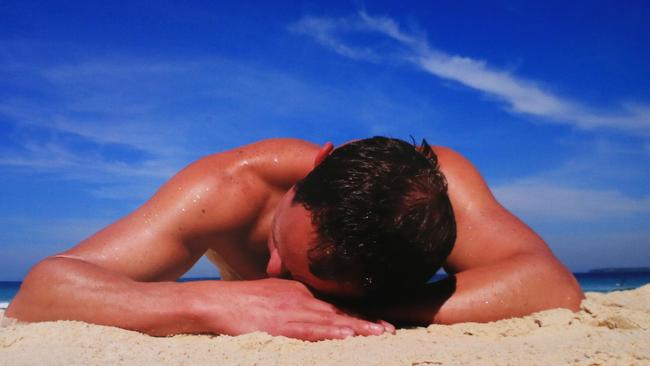Carefree summer days? I don’t think so
Have you noticed how different it feels now when we get those really hot days? And have you thought about why that is?
Opinion
Don't miss out on the headlines from Opinion. Followed categories will be added to My News.
I’D never seen the Southern Midlands so lush. Northbound on the highway last weekend, I was like a greedy grazier drinking in the abundant pasture that was springing after good rain.
Such a scene used to make my heart sing. Verdancy felt like a miracle, I suppose, on farmland that so often looked dry and depleted.
The sight did spring joy, briefly. I marvelled for a minute. Then the song cut short with the brutality of a daughter kicking me and my Johnny Cash tunes off our shared Spotify account.
Even a pastoral idyll is a loaded landscape for me now. I’ve been burnt. I’ve seen the pattern too many times now, a wet spring of exuberant growth followed by a scorching summer that turns it all into bushfire fuel to be torched.

Picture supplied by Mercury reader Angela Brinkhoff
Living in northern NSW in the noughties, I noticed bushfire smoke drifting across my horizons – physical and psychic – with growing frequency. Gorgeous soft springs were cruelled by dry heat again and again.
Because the syndrome was unlike the extended drought of my childhood and because it did not happen every single year, it took me a while to twig to the pattern. When I did, the Trojan-horsing of bad summers felt like a new normal.
I spent uneasy days watching smoke and scanning for flare-ups in the forests beyond Hanging Rock, but mostly the fire risk seemed manageable. When I sensed danger, I also had faith that the men around us would keep us safe or get us out in time. (Dangerously quaint mindset, I know – men like Shane Fitzsimmons, the former state fire chief this week named NSW Australian of the Year, are a critically endangered species.)
One night I was caught in a wild electrical storm with my eldest daughter, still a tiny thing, when driving up the coastal side of the Great Dividing Range to Dorrigo from the low-lying river town of Bellingen.
This narrow section of the Waterfall Way cuts into the mountainside and I had nowhere to pull over in the torrential downpour.
I tried to be brave for my baby, but I was terrified, and it only got worse when we hit the exposed plateau, when I wondered how the lightning could possibly fail to strike us in our little metal box.
When we arrived at our friends’ house and the father ran out with a big umbrella to rush us into the home, I was relieved on a scale that I usually feel only after birthing a baby without pain relief.
The storm went away. It was all over and my little girl was safe. There was no inferno to follow.
I understood the experience as an isolated incident in a place notorious for its violent electrical storms: one afternoon a year or two later, in 2005, lightning strikes just west of Dorrigo killed 68 dairy cows waiting to be milked.
I had no sense whatsoever of the event as a portent of catastrophic fire events like the one that burnt down our family’s forest hut at nearby Clouds Creek last summer.
It all feels different to me now. Because it is. Accelerating climate change puts almost everything we know and love at risk, including that cherished part of our country’s culture – our carefree summers. When the temperature hit 30C+ this week, I didn’t think about the beach. I thought about bushfire risk. At one point the two converged and the vision of thousands of people sheltering on the beach at Mallacoota under a blood-red sky sprang to mind. That was only 10 months ago.

Even if there are no catastrophic dry-lightning storms this summer – and predictions are for milder conditions – our carefree summers are history unless we can change the global warming trajectory by dramatically reducing our reliance on fossil fuels.
Today, I am calling on the Tasmanian and federal governments to step up.
There is so much more we need to do right now to hold onto to the things we hold so dear. We will not be spared just because we live on a temperate island.

or me, today, it’s a certain lost sense of summer freedom.
For you, it may be a favourite bird you don’t see anymore. Or recognition that your dream of owning a little farm one day ain’t going to happen, because we are likely to get priced out by foreign nationals securing arable land not just as a general investment but for their country’s food security.
Tasmania may be a well-credentialed renewable electricity supplier, but our emissions are right up there with other big polluters. It’s mostly only the reduction in forestry activity over the past decade that counters our woeful emissions on a ledger that few people even seem aware of.

The biennial State of the Climate Report released yesterday by the Bureau of Meteorology and CSIRO was unequivocal in its message that Australia is experiencing climate change.
The report reveals that 2019 was the hottest Australian year on record, with the national daily maximum temperature exceeding 39C on 33 days.
It also highlighted a significant increase in the frequency of dangerous fire weather, leading to an earlier start to the southern fire season.
And it showed that 2020’s COVID-related carbon-emissions slowdown is having a negligible effect on slowing global warming.
Happy days.
amanda.ducker@news.com.au
READ MORE OF AMANDA DUCKER’S BUSHFIRE STORIES HERE:
RING OF FIRE: HOW TO MAKE COMBUSTIBLE HOBART FIRE-SAFE
WE BEGGED PM TO LISTEN TO OUR WARNING: EX FIRE CHIEFS TELL
TASWEEKEND: WE ARE ALL SITTING IN THE LINE OF FIRE
READ AMANDA’S COLUMN LAST WEEK HERE:


